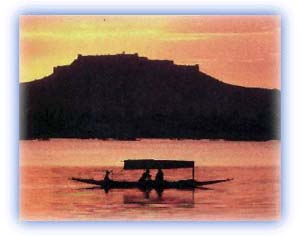Dal and Nagin lakes
The Dal and the Nagin lakes with their houseboats and shikaras
were major tourist destinations in the 1970s and 1980s before
trouble in the region started discouraging tourists. The tourist
boom, and the lakes and waterways of Kashmir, strongly affected
the population of Kashmir. Tourists' fascination with houseboats
led to the creation of a large number of luxurious floating
hotels. The increase in tourism also had its downsides. Most of
the lakes in Kashmir have been formed from ancient oxbows created
by the Jhelum river as it meandered across the valley floor. The
present lakes are only a shrunken shadow of their former selves.
The Dal Lake has shrunk in the past 50 years to half its size,
from 22 sq. km. to about 11 sq. km. The Dal Lake of Srinagar is
a prime example of degradation in a Himalayan lake eco-system. |
 | Shikara in the Dal Lake
Credit: KOA |
Eutrophication is a process that occurs when a water body becomes
abnormally rich in nutrients, often by artificial means. This
results in abnormal and excessive plant growth. The runoff of
chemical fertilizers from the vast drainage basin around the
lake, sewage and other oxygen demanding wastes are responsible
for bringing in 15 tons of phosphorous and 300 tons of nitrogen
every year. These elements promote excessive plant growth on the
surface of the lake. As a result the lake's internal life
processes fall under severe stress as oxygen does not reach the
depths of the lake, since it is blocked by the plants at the
surface. The falling of oxygen levels means that fish die out.
The decaying of organic matter produces disagreeable odors, and
the green scum of algae and weed infested waterways are an
eyesore.
From the tourist's point of view, the best initial exploration
of Srinagar is to board a shikara and follow its course through
the heart of the city, past willow-shaded channels and canals and
under the bridges. This is what many people did during the 1970s
and 1980s when tourism was at its peak.
 | Homeward bound
a shikara at sunset on the Dal Lake
Credit: KOA |
A traveler describes this as follows: "At first sight, the city's
interior has a spectacular tattiness; the mud, brick and wood
houses are crammed cheek by jowl along the waterfront; some look
as if they are crumbling and others are indeed propped up with
stout pillars of timber. But the impression of decay and disorder
recedes as the pattern for living emerges. The river is a place
that people live on, as well as live along. Lines of doongas are
moored along its banks, the homes of the boat people. Women sit
at the prows, pounding grain or calling to each other. As a major
artery, the river is punctuated at regular intervals by landing
stages leading up to narrow labyrinth-like lanes which connect
to the streets beyond, so that there is a constant flow of
activity between water and land. Bahatches load or unload cargo.
Homes, shops, schools, places of work and worship cluster around
the waterfront, a variety within a cohesive unit. Roof-gardens
and orchards tumble over the river wall, and carved or latticed
windows add a touch of richness. After an hour on the river, you
realize that the ugliest buildings are those that are new,
slapped together with unattractive concrete and topped with
galvanized iron roofing."
|

![]()

